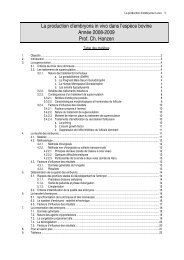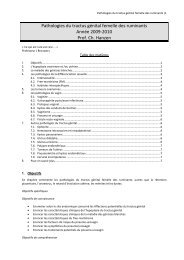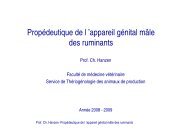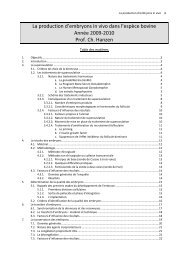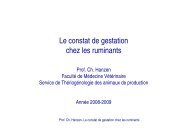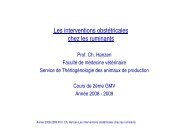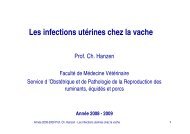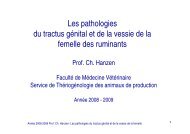100 jours pour réussir le post-partum ou comment maîtriser les ...
100 jours pour réussir le post-partum ou comment maîtriser les ...
100 jours pour réussir le post-partum ou comment maîtriser les ...
- No tags were found...
Create successful ePaper yourself
Turn your PDF publications into a flip-book with our unique Google optimized e-Paper software.
ObjectifsCe chapitre se propose de définir <strong>le</strong>s notions de périodeassociées au cyc<strong>le</strong> de reproduction bovine et d’illustrer <strong>le</strong>sfacteurs individuels et de tr<strong>ou</strong>peau responsab<strong>le</strong>s d’infertilité etd’infécondité. Il veut éga<strong>le</strong>ment illustrer la complémentarité entreune approche individuel<strong>le</strong> et de tr<strong>ou</strong>peau. Cette d<strong>ou</strong>b<strong>le</strong> approcheimplique une stratégie de col<strong>le</strong>cte et d’analyse des données.Ces objectifs seront illustrés par divers exemp<strong>le</strong>s.Prof Ch. Hanzen <strong>100</strong> <strong>j<strong>ou</strong>rs</strong> <strong>p<strong>ou</strong>r</strong> <strong>le</strong> <strong>post</strong>-<strong>partum</strong>. Introduction généra<strong>le</strong> au c<strong>ou</strong>rs de Thériogenologie de 2 ème graduat
Notions de fécondité et de fertilitéProf Ch. Hanzen <strong>100</strong> <strong>j<strong>ou</strong>rs</strong> <strong>p<strong>ou</strong>r</strong> <strong>le</strong> <strong>post</strong>-<strong>partum</strong>. Introduction généra<strong>le</strong> au c<strong>ou</strong>rs de Thériogenologie de 2 ème graduat
IA1IFIA1IFLa fertilité est une notion de nombred’inséminations nécessairesà l’obtention d’une gestation (< 3 <strong>ou</strong> > 2)IA1NaissanceV1 V2 V3VnRéfPérioded’attentePériode dereproductionPériode degestation24 mois 365 <strong>j<strong>ou</strong>rs</strong>La fécondité est une notionde temps nécessaire à l’obtentiond’une gestation <strong>ou</strong> … d’un vêlageDernière IAProf Ch. Hanzen <strong>100</strong> <strong>j<strong>ou</strong>rs</strong> <strong>p<strong>ou</strong>r</strong> <strong>le</strong> <strong>post</strong>-<strong>partum</strong>. Introduction généra<strong>le</strong> au c<strong>ou</strong>rs de Thériogenologie de 2 ème graduat
L ’infertilité : définition• incapacité temporaire d’une femel<strong>le</strong> à produire des ovocytesfécondab<strong>le</strong>s.• En pratique, dans <strong>le</strong>s bilans de reproduction, on restreint <strong>le</strong>sens du terme aux femel<strong>le</strong>s inséminées : Etat d’une femel<strong>le</strong> secaractérisant par la nécessité de rec<strong>ou</strong>rir à plus de deuxinséminations <strong>p<strong>ou</strong>r</strong> obtenir, <strong>ou</strong> non, une gestation.• Au niveau du tr<strong>ou</strong>peau, l’infertilité s’évalue au moyen dedifférents paramètres : indice de fertilité, taux de gestation, tauxde réussite, taux de mise bas, taux de non ret<strong>ou</strong>r.Prof Ch. Hanzen <strong>100</strong> <strong>j<strong>ou</strong>rs</strong> <strong>p<strong>ou</strong>r</strong> <strong>le</strong> <strong>post</strong>-<strong>partum</strong>. Introduction généra<strong>le</strong> au c<strong>ou</strong>rs de Thériogenologie de 2 ème graduat
L ’infécondité : définition• au sens propre, incapacité d’une femel<strong>le</strong> de mener à terme sagestation,en mettant bas un produit vivant et viab<strong>le</strong>.• Notion économique exprimée : temps nécessaire à l’obtention <strong>ou</strong>non d’une gestation dans <strong>le</strong> tr<strong>ou</strong>peau des génisses par un âge au premier vêlagesupérieur à 24 voire 36 mois selon <strong>le</strong>s races <strong>ou</strong> par un interval<strong>le</strong>entre la naissance et l ’insémination fécondante (NIF) de 15 voire17 mois. dans <strong>le</strong> tr<strong>ou</strong>peau des vaches, par un interval<strong>le</strong> entre deux vêlagessuccessifs (V-V) <strong>ou</strong> un interval<strong>le</strong> entre <strong>le</strong> vêlage et l’inséminationfécondante (V-IF) respectivement supérieurs à 365 (380 ?) et 85(<strong>100</strong> ?) <strong>j<strong>ou</strong>rs</strong>.Prof Ch. Hanzen <strong>100</strong> <strong>j<strong>ou</strong>rs</strong> <strong>p<strong>ou</strong>r</strong> <strong>le</strong> <strong>post</strong>-<strong>partum</strong>. Introduction généra<strong>le</strong> au c<strong>ou</strong>rs de Thériogenologie de 2 ème graduat
Evolution des performances de reproductionQuelques donnéesQuébecEspagneFranceProf Ch. Hanzen <strong>100</strong> <strong>j<strong>ou</strong>rs</strong> <strong>p<strong>ou</strong>r</strong> <strong>le</strong> <strong>post</strong>-<strong>partum</strong>. Introduction généra<strong>le</strong> au c<strong>ou</strong>rs de Thériogenologie de 2 ème graduat
Evolution mensuel<strong>le</strong> du VIF dans <strong>le</strong>s tr<strong>ou</strong>peaux laitiers du Québec(> 1990 à 2002) Données ASTLQ (E. B<strong>ou</strong>chard FMV St Hyacinthe (AERA 2002)16 015 014 013 012 01 1 010 09 08 07 01 8 1 5 2 2 2 9 3 6 4 3 5 0 5 7 6 4 7 1 7 8 8 5 9 2 9 9 10 6 1 1 3 1 2 0 12 7 1 3 4 1 4 1 14 8Prof Ch. Hanzen <strong>100</strong> <strong>j<strong>ou</strong>rs</strong> <strong>p<strong>ou</strong>r</strong> <strong>le</strong> <strong>post</strong>-<strong>partum</strong>. Introduction généra<strong>le</strong> au c<strong>ou</strong>rs de Thériogenologie de 2 ème graduat
Evolution du taux de gestation total en 1ère IA dans <strong>le</strong>s tr<strong>ou</strong>peauxASTLQ 1990-2001 Québec : E. B<strong>ou</strong>chard FMV St Hyacinthe (AERA2002)504540353090 91 92 93 94 95 96 97 98 99 0 1Prof Ch. Hanzen <strong>100</strong> <strong>j<strong>ou</strong>rs</strong> <strong>p<strong>ou</strong>r</strong> <strong>le</strong> <strong>post</strong>-<strong>partum</strong>. Introduction généra<strong>le</strong> au c<strong>ou</strong>rs de Thériogenologie de 2 ème graduat
Evolution du taux de gestation total (%) (nombre de vachesgestantes / n de vaches inséminées) dans 4 exploitations laitières(10636 vaches inséminées) (Lopez-Gatius Theriogenology 3003,60, 89-99)4540353025201510501991 1992 1993 1994 1995 1996 1997 1998 1999 2000Prof Ch. Hanzen <strong>100</strong> <strong>j<strong>ou</strong>rs</strong> <strong>p<strong>ou</strong>r</strong> <strong>le</strong> <strong>post</strong>-<strong>partum</strong>. Introduction généra<strong>le</strong> au c<strong>ou</strong>rs de Thériogenologie de 2 ème graduat
Evolution du TNR (56 <strong>j<strong>ou</strong>rs</strong>) en 1ère IA (156.730/an) dans <strong>le</strong>str<strong>ou</strong>peaux laitiers français de 1988 à 1997(Chevalier et Humblot 1998) (AERA 2002)60595857565554535251501 2 3 4 5 6 7 8 9 10Prof Ch. Hanzen <strong>100</strong> <strong>j<strong>ou</strong>rs</strong> <strong>p<strong>ou</strong>r</strong> <strong>le</strong> <strong>post</strong>-<strong>partum</strong>. Introduction généra<strong>le</strong> au c<strong>ou</strong>rs de Thériogenologie de 2 ème graduat
400Evolution de l’interval<strong>le</strong> entre vêlages en fonction du numéro delactation dans la race HolsteinD. Boichard Dept Génétique anima<strong>le</strong> INRA J<strong>ou</strong>y en Josas (AERA 2002)395390385380L1-L2L2-L3L3-L437537036581 82 83 84 85 86 87 88 89 90 91 92 93 94 95 96 97 98 99 0Prof Ch. Hanzen <strong>100</strong> <strong>j<strong>ou</strong>rs</strong> <strong>p<strong>ou</strong>r</strong> <strong>le</strong> <strong>post</strong>-<strong>partum</strong>. Introduction généra<strong>le</strong> au c<strong>ou</strong>rs de Thériogenologie de 2 ème graduat
Notion de facteur de risqueFacteur associé à l ’augmentation de la probabilité d ’apparition <strong>ou</strong> dedéveloppement d ’un phénomène pathologique.Cette association de causalité est <strong>ou</strong> non démontrée statistiquement.Notion d’indicateur de risqueélément associé à la pathologie sans en être nécessairement la causeProf Ch. Hanzen <strong>100</strong> <strong>j<strong>ou</strong>rs</strong> <strong>p<strong>ou</strong>r</strong> <strong>le</strong> <strong>post</strong>-<strong>partum</strong>. Introduction généra<strong>le</strong> au c<strong>ou</strong>rs de Thériogenologie de 2 ème graduat
Nature des facteurs de risque• Facteurs individuels <strong>ou</strong> col<strong>le</strong>ctifs• Effet direct <strong>ou</strong> indirect• Effet isolé <strong>ou</strong> synergique• Nature anatomique, infectieuse, hormona<strong>le</strong>, thérapeutique <strong>ou</strong>zootechnique• Animal <strong>ou</strong> responsab<strong>le</strong>s de l ’é<strong>le</strong>vage (é<strong>le</strong>veur, technicien,vétérinaire : des BPV…)• Effets pendant la période d ’attente et/<strong>ou</strong> la période dereproduction : effets sur la fécondité et/<strong>ou</strong> la fertilitéProf Ch. Hanzen <strong>100</strong> <strong>j<strong>ou</strong>rs</strong> <strong>p<strong>ou</strong>r</strong> <strong>le</strong> <strong>post</strong>-<strong>partum</strong>. Introduction généra<strong>le</strong> au c<strong>ou</strong>rs de Thériogenologie de 2 ème graduat
From Senger 2002Prof Ch. Hanzen <strong>100</strong> <strong>j<strong>ou</strong>rs</strong> <strong>p<strong>ou</strong>r</strong> <strong>le</strong> <strong>post</strong>-<strong>partum</strong>. Introduction généra<strong>le</strong> au c<strong>ou</strong>rs de Thériogenologie de 2 ème graduat
Facteurs individuels• Age• Génétique• Production laitière• Type de vêlage• Gémellité• Mortalité périnata<strong>le</strong>• Rétention placentaire, fièvre vitulaire, acétonémie• Involutions cervica<strong>le</strong> et utérine• Infections du tractus génital• Activité ovarienne au c<strong>ou</strong>rs du <strong>post</strong>-<strong>partum</strong>• Etc, etc……..Prof Ch. Hanzen <strong>100</strong> <strong>j<strong>ou</strong>rs</strong> <strong>p<strong>ou</strong>r</strong> <strong>le</strong> <strong>post</strong>-<strong>partum</strong>. Introduction généra<strong>le</strong> au c<strong>ou</strong>rs de Thériogenologie de 2 ème graduat
Facteurs col<strong>le</strong>ctifs• Politique d'insémination au c<strong>ou</strong>rs du <strong>post</strong><strong>partum</strong>• Détection des cha<strong>le</strong>urs• Moment d'insémination pendant <strong>le</strong>s cha<strong>le</strong>urs• Nutrition• Saison• Politique de prévention sanitaire• Type de stabulation (libre, entravée)• Tail<strong>le</strong> du tr<strong>ou</strong>peau• Qualité du sperme• Technicité de l'inséminateur• Aspects sociologiquesProf Ch. Hanzen <strong>100</strong> <strong>j<strong>ou</strong>rs</strong> <strong>p<strong>ou</strong>r</strong> <strong>le</strong> <strong>post</strong>-<strong>partum</strong>. Introduction généra<strong>le</strong> au c<strong>ou</strong>rs de Thériogenologie de 2 ème graduat
Notions de rentabilitéProf Ch. Hanzen <strong>100</strong> <strong>j<strong>ou</strong>rs</strong> <strong>p<strong>ou</strong>r</strong> <strong>le</strong> <strong>post</strong>-<strong>partum</strong>. Introduction généra<strong>le</strong> au c<strong>ou</strong>rs de Thériogenologie de 2 ème graduat
VenteNaissanceV1 V2 V3VnRéfVeau vivantet viab<strong>le</strong>Veau vivantet viab<strong>le</strong>Veau vivantet viab<strong>le</strong>Veau vivantet viab<strong>le</strong>Prof Ch. Hanzen <strong>100</strong> <strong>j<strong>ou</strong>rs</strong> <strong>p<strong>ou</strong>r</strong> <strong>le</strong> <strong>post</strong>-<strong>partum</strong>. Introduction généra<strong>le</strong> au c<strong>ou</strong>rs de Thériogenologie de 2 ème graduat
Notions de périodesProf Ch. Hanzen <strong>100</strong> <strong>j<strong>ou</strong>rs</strong> <strong>p<strong>ou</strong>r</strong> <strong>le</strong> <strong>post</strong>-<strong>partum</strong>. Introduction généra<strong>le</strong> au c<strong>ou</strong>rs de Thériogenologie de 2 ème graduat
NaissanceV1 V2 V3VnRéfNotions de périodesProf Ch. Hanzen <strong>100</strong> <strong>j<strong>ou</strong>rs</strong> <strong>p<strong>ou</strong>r</strong> <strong>le</strong> <strong>post</strong>-<strong>partum</strong>. Introduction généra<strong>le</strong> au c<strong>ou</strong>rs de Thériogenologie de 2 ème graduat
Notion de périodesComparaison vaches/génissesPériode d’attentePériode de reproductionPériode de gestationGénisseN1IAIFVVache 1234Prof Ch. Hanzen <strong>100</strong> <strong>j<strong>ou</strong>rs</strong> <strong>p<strong>ou</strong>r</strong> <strong>le</strong> <strong>post</strong>-<strong>partum</strong>. Introduction généra<strong>le</strong> au c<strong>ou</strong>rs de Thériogenologie de 2 ème graduat
<strong>100</strong> <strong>j<strong>ou</strong>rs</strong> <strong>p<strong>ou</strong>r</strong> réussir <strong>le</strong> <strong>post</strong><strong>partum</strong>Vêlage 2InvolutionPériode sècheAnoestrusFin de la gestationAttenteTransitionReproGest-60-200 +20 +30 +50 +80Prof Ch. Hanzen <strong>100</strong> <strong>j<strong>ou</strong>rs</strong> <strong>p<strong>ou</strong>r</strong> <strong>le</strong> <strong>post</strong>-<strong>partum</strong>. Introduction généra<strong>le</strong> au c<strong>ou</strong>rs de Thériogenologie de 2 ème graduat
Tarissement V Attente Rep GestationDystocies (J0)Rétention placentaire (J1)Fièvre vitulaireAcétonémie (3 à 6 sem)Déplacements de cail<strong>le</strong>tteMétrite aigueMétrite chroniqueRetard d’involution utérineKystesAnoestrus pathologique fonctionnelNon fécondationMort embryonnaire précoceMort embryonnaire tardiveAvortementsBalance énergétique négativeMammite aigueMammite chroniqueBoiteriesAcidose métaboliqueProf Ch. Hanzen <strong>100</strong> <strong>j<strong>ou</strong>rs</strong> <strong>p<strong>ou</strong>r</strong> <strong>le</strong> <strong>post</strong>-<strong>partum</strong>. Introduction généra<strong>le</strong> au c<strong>ou</strong>rs de Thériogenologie de 2 ème graduat
Fréquences moyennes et va<strong>le</strong>urs min et max (%) de quelques pathologies dans 61tr<strong>ou</strong>peaux laitiers américains(Jordan et al. J.Dairy Sci. 1993,76,3247-3256)706050403020<strong>100</strong>FV DC Acét RP MétProf Ch. Hanzen <strong>100</strong> <strong>j<strong>ou</strong>rs</strong> <strong>p<strong>ou</strong>r</strong> <strong>le</strong> <strong>post</strong>-<strong>partum</strong>. Introduction généra<strong>le</strong> au c<strong>ou</strong>rs de Thériogenologie de 2 ème graduat
Le dépassement des <strong>100</strong> <strong>j<strong>ou</strong>rs</strong> n’est pas une fatalitéLa réduction de ce délai implique une stratégieLe raisonnement hypothético-déductifConnaître <strong>le</strong>s bonnes hypothèsesP<strong>ou</strong>voir justifier <strong>le</strong>s bonnes hypothèses : EBMAvoir <strong>le</strong>s informations <strong>p<strong>ou</strong>r</strong> <strong>le</strong>s accepter <strong>ou</strong> <strong>le</strong>s rejeterStratégie de col<strong>le</strong>cte des données sur l’individuOutils et méthodes d’analyseProf Ch. Hanzen <strong>100</strong> <strong>j<strong>ou</strong>rs</strong> <strong>p<strong>ou</strong>r</strong> <strong>le</strong> <strong>post</strong>-<strong>partum</strong>. Introduction généra<strong>le</strong> au c<strong>ou</strong>rs de Thériogenologie de 2 ème graduat
De l’individu ….… au tr<strong>ou</strong>peauProf Ch. Hanzen <strong>100</strong> <strong>j<strong>ou</strong>rs</strong> <strong>p<strong>ou</strong>r</strong> <strong>le</strong> <strong>post</strong>-<strong>partum</strong>. Introduction généra<strong>le</strong> au c<strong>ou</strong>rs de Thériogenologie de 2 ème graduat
Le raisonnement hypothéthico-déductifl’exemp<strong>le</strong> des <strong>100</strong> <strong>j<strong>ou</strong>rs</strong>Prof Ch. Hanzen <strong>100</strong> <strong>j<strong>ou</strong>rs</strong> <strong>p<strong>ou</strong>r</strong> <strong>le</strong> <strong>post</strong>-<strong>partum</strong>. Introduction généra<strong>le</strong> au c<strong>ou</strong>rs de Thériogenologie de 2 ème graduat
Allongement du VIFAllongement PRAllongement PAEC > 3,5 pre<strong>partum</strong>VolontaireSaisonnalitéVLHPcapacité d’ingestionmanque d’apportsInvolontaireAn. de détectionAn. pathologiquefonctionnelkystiqueBENbesoins excessifsEndo chroniquespyométralEndo 1 er , 2 ème degréRIUDiagnostic tardif des endoGémellitéDYSTECEndo aigueFVRPFVRPDYSTGerme spécifiquematernel<strong>le</strong>sfoeta<strong>le</strong>sProf Ch. Hanzen <strong>100</strong> <strong>j<strong>ou</strong>rs</strong> <strong>p<strong>ou</strong>r</strong> <strong>le</strong> <strong>post</strong>-<strong>partum</strong>. Introduction généra<strong>le</strong> au c<strong>ou</strong>rs de Thériogenologie de 2 ème graduat
Allongement du VIFAllongement PRAllongement PAInfertilitéFréquence de détectionNon fécondationME précoceME tardiveAvortementsEndométrites chroniquesFacteurs propres à l’embryonFacteurs biologiquesExactitude de la détectionKystesQualité de l’IAQualité du recrutement folliculaireGestion du spermeFacteurs biologiquesFacteurs environnementauxFacteurs parentauxFIVETEFacteurs non biologTraitements hormonauxBENStress thermiqueProf Ch. Hanzen <strong>100</strong> <strong>j<strong>ou</strong>rs</strong> <strong>p<strong>ou</strong>r</strong> <strong>le</strong> <strong>post</strong>-<strong>partum</strong>. Introduction généra<strong>le</strong> au c<strong>ou</strong>rs de Thériogenologie de 2 ème graduat
La stratégie de col<strong>le</strong>cte des donnéesLe cas des vachesProf Ch. Hanzen <strong>100</strong> <strong>j<strong>ou</strong>rs</strong> <strong>p<strong>ou</strong>r</strong> <strong>le</strong> <strong>post</strong>-<strong>partum</strong>. Introduction généra<strong>le</strong> au c<strong>ou</strong>rs de Thériogenologie de 2 ème graduat
Suivis thérapeutiquesindividuels FV, RP, MA , DCECStatut ovarienExamen des inferti<strong>le</strong>sECpHurineAGNEECBHBCtrl IU20-50Statut utérinVaginoscopieRapport MG:ProtDépister boiteriesECKystesVaginoscopieTARVIUGEST PA PR GESTPTDépister pneumovaginAnoestrus fonctionnelAnoestrus détectionInductionDépistageanoestrus50-60Prof Ch. Hanzen <strong>100</strong> <strong>j<strong>ou</strong>rs</strong> <strong>p<strong>ou</strong>r</strong> <strong>le</strong> <strong>post</strong>-<strong>partum</strong>. Introduction généra<strong>le</strong> au c<strong>ou</strong>rs de Thériogenologie de 2 ème graduatECStatut ovarienPyomètreSanté mammaireDg MEDiagnosticprécoce25-35InductionMETDiagnostictardif50-80InductionEC
Prof Ch. Hanzen <strong>100</strong> <strong>j<strong>ou</strong>rs</strong> <strong>p<strong>ou</strong>r</strong> <strong>le</strong> <strong>post</strong>-<strong>partum</strong>. Introduction généra<strong>le</strong> au c<strong>ou</strong>rs de Thériogenologie de 2 ème graduat
Prof Ch. Hanzen <strong>100</strong> <strong>j<strong>ou</strong>rs</strong> <strong>p<strong>ou</strong>r</strong> <strong>le</strong> <strong>post</strong>-<strong>partum</strong>. Introduction généra<strong>le</strong> au c<strong>ou</strong>rs de Thériogenologie de 2 ème graduat
Le contrô<strong>le</strong> de l’état corporel et de labalance énergétiqueProf Ch. Hanzen <strong>100</strong> <strong>j<strong>ou</strong>rs</strong> <strong>p<strong>ou</strong>r</strong> <strong>le</strong> <strong>post</strong>-<strong>partum</strong>. Introduction généra<strong>le</strong> au c<strong>ou</strong>rs de Thériogenologie de 2 ème graduat
ECExamen des inferti<strong>le</strong>sECECCtrl IU20-50ECTARIUGEST PA PR GESTPTECDépistageanoestrus50-60Diagnostictardif50-80ECProf Ch. Hanzen <strong>100</strong> <strong>j<strong>ou</strong>rs</strong> <strong>p<strong>ou</strong>r</strong> <strong>le</strong> <strong>post</strong>-<strong>partum</strong>. Introduction généra<strong>le</strong> au c<strong>ou</strong>rs de Thériogenologie de 2 ème graduat
Contrô<strong>le</strong>r la BEN avant et après <strong>le</strong> vêlageCétoseDystocie- Eviter la surpopulationBEN- Accès optimal à l’eaupre<strong>partum</strong> RP- Eviter changements alimentaires- Favoriser <strong>le</strong> confortDC- Eviter changements de gr<strong>ou</strong>pes 12 vaches 1 sem- Eviter pâturages < 7 cmAvant <strong>le</strong> repasFV>10 % : AGNE- % de refus : 2 à 3 %> 0,4 mmol/l- Rec<strong>ou</strong>rs à des RTM MammitesDépressionimmunitaireMétritesN si TP : > 3,05Taux protéique : < 2,9 %Taux MG : > 4,8 %capacité d’ingestion<strong>post</strong><strong>partum</strong>N si < 1,5Rapport MG/Prot : > 1,4Taux de lactose : < 4,5 %BEN<strong>post</strong><strong>partum</strong>12 vaches J5-J50 PP4-5 h après <strong>le</strong> repas> 10 % : BHB > 1,2-1,4 mmol/lProf Ch. Hanzen <strong>100</strong> <strong>j<strong>ou</strong>rs</strong> <strong>p<strong>ou</strong>r</strong> <strong>le</strong> <strong>post</strong>-<strong>partum</strong>. Introduction généra<strong>le</strong> au c<strong>ou</strong>rs de Thériogenologie de 2 ème graduat
Paramètres de diagnostic d’une BEN dans <strong>le</strong>s tr<strong>ou</strong>peaux laitiers(Mulligan et al. 2006)Percentage of energy requirements supplied 8 weeks aftercalvingBCS at drying offBCS at calving% of cows with >0.5 units BCS loss in early lactationBCS at breeding% of early lactation cows with milk/milk protein > 1.5% of early lactation cows with nadir milk protein < 3.05%% of early lactation cows with nadir milk lactose < 4.5%Weekly decline in milk yield (%) <strong>post</strong>-peakTr<strong>ou</strong>gh space for transition cowsPercentage refusals accepted in transition cow tr<strong>ou</strong>ghPost-grazing sward height for early lactation cows% cows 2–14 days pre-calving with blood BHB > 0.6 mmol/% cows 2–14 days pre-calving with blood NEFA > 0.4 mmol/l% early lactating cows with blood BHB > 1.4 mmol/l% early lactating cows with blood NEFA > 0.7 mmol/l≈95%2.753.02.5
Le contrô<strong>le</strong> du rumenProf Ch. Hanzen <strong>100</strong> <strong>j<strong>ou</strong>rs</strong> <strong>p<strong>ou</strong>r</strong> <strong>le</strong> <strong>post</strong>-<strong>partum</strong>. Introduction généra<strong>le</strong> au c<strong>ou</strong>rs de Thériogenologie de 2 ème graduat
Causes et conséquences de l’acidose du rumenIngestion excessiveChangement sans transitionFlore inadaptéeRations riche en énergieMultiplication des bactéries produisant de l’HL dextrogyreDisparition des bactéries transformant l’HL en AGVVaches au picVaches 80 -150 j PPInfertilté - inféconditéDiminution de la capacité d’ingestionDiminution de la ruminationDiminution du score des MFSyndrome de la VC <strong>post</strong>érieureDC et ulcéresDiminution de l’immunitéBoiteries : problème si > 15 %Acidose cliniqueSubclinique (SARA)pH rumen : 3,9 à 4,5RumenocentèseTube stomacal3 vaches/12 : < 5,5Prof Ch. Hanzen <strong>100</strong> <strong>j<strong>ou</strong>rs</strong> <strong>p<strong>ou</strong>r</strong> <strong>le</strong> <strong>post</strong>-<strong>partum</strong>. Introduction généra<strong>le</strong> au c<strong>ou</strong>rs de Thériogenologie de 2 ème graduat
Acidose et reproductionAcidose du rumenAltérations de la so<strong>le</strong>et hémorragiesLibération d’endotoxinespar <strong>le</strong>s Gram -Boiteries(hyperalgésieet d<strong>ou</strong><strong>le</strong>ur)Réductiondes montesRéductiondu tempsd’alimentationSynthèse de catécholaminescorticoïdes et P4par <strong>le</strong>s surréna<strong>le</strong>sAugmentationde la BE -Réduction de la qualitéde la détection de l’oestrusInhibition de la LHKystesAnoestrus InfertilitéInféconditéPAPRProf Ch. Hanzen <strong>100</strong> <strong>j<strong>ou</strong>rs</strong> <strong>p<strong>ou</strong>r</strong> <strong>le</strong> <strong>post</strong>-<strong>partum</strong>. Introduction généra<strong>le</strong> au c<strong>ou</strong>rs de Thériogenologie de 2 ème graduat
Critères de contrô<strong>le</strong> de la fonction ruména<strong>le</strong> (Mulligan et al. 2006)Lameness incidenceLaminitis incidenceIncidence of displaced abomasums% resting cows ruminatingChews per bolus in resting cowsErratic feed intakeFaecal consistency scoreFaecal sieve test All partic<strong>le</strong>sGr<strong>ou</strong>ps 13mm 30%% forage <strong>le</strong>ngth : >40mm 5–10%Long fibre in the rationkg of concentrate fed at milkingRate of increase in concentrates after calvingFeed space availab<strong>le</strong> per animal80%70yes/no3< 0.5 cm≤2.5%
Le contrô<strong>le</strong> de la santé mammaireProf Ch. Hanzen <strong>100</strong> <strong>j<strong>ou</strong>rs</strong> <strong>p<strong>ou</strong>r</strong> <strong>le</strong> <strong>post</strong>-<strong>partum</strong>. Introduction généra<strong>le</strong> au c<strong>ou</strong>rs de Thériogenologie de 2 ème graduat
Comparaison de l'index de fertilité en fonction du moment d'apparition de lamammite <strong>ou</strong> de sa nature4,54Barker et al. 1998 Schrick 20013,532,521,510,50Av t IA1Entre IA1 etTémoins <strong>ou</strong>Subclin Clin Subclin v ersTémoinsgestationaprès GestclinProf Ch. Hanzen <strong>100</strong> <strong>j<strong>ou</strong>rs</strong> <strong>p<strong>ou</strong>r</strong> <strong>le</strong> <strong>post</strong>-<strong>partum</strong>. Introduction généra<strong>le</strong> au c<strong>ou</strong>rs de Thériogenologie de 2 ème graduat
MammitescortisolEndotoxineshyperthermieSystèmeopioideRéduction de lasynthèse de LHeffet cytotoxiquesur <strong>le</strong>s cellu<strong>le</strong>slutéa<strong>le</strong>s (IFNg, TNF)Cytokines(inter<strong>le</strong>ukines,interférons, TNF …)Réduction dela proliférationépithélia<strong>le</strong> del’oviducte etde l’utérusInhibition del’effet FSHsur l’oestradiol(IL6)CompétenceovocytairePGFLutéolyseprématuréeRéductionde la synthèsede P4apoptosedes blastomèresMortalitéembryonnaireInféconditéPRProf Ch. Hanzen <strong>100</strong> <strong>j<strong>ou</strong>rs</strong> <strong>p<strong>ou</strong>r</strong> <strong>le</strong> <strong>post</strong>-<strong>partum</strong>. Introduction généra<strong>le</strong> au c<strong>ou</strong>rs de Thériogenologie de 2 ème graduat
A emporter …• Remise en question de la démarche diagnostique au niveauindividuel et de tr<strong>ou</strong>peau• Organisation temporel<strong>le</strong> des examens cliniques lors desmoments clés• Systématisation des examens cliniques• Notation des informations• Rec<strong>ou</strong>rs à des systèmes d’analyse des données Quantification des données Comparaison à des va<strong>le</strong>urs de référence Formu<strong>le</strong>r des recommandations objectivesProf Ch. Hanzen <strong>100</strong> <strong>j<strong>ou</strong>rs</strong> <strong>p<strong>ou</strong>r</strong> <strong>le</strong> <strong>post</strong>-<strong>partum</strong>. Introduction généra<strong>le</strong> au c<strong>ou</strong>rs de Thériogenologie de 2 ème graduat
Merci de votre excel<strong>le</strong>nte attention .Des questions ?Prof Ch. Hanzen <strong>100</strong> <strong>j<strong>ou</strong>rs</strong> <strong>p<strong>ou</strong>r</strong> <strong>le</strong> <strong>post</strong>-<strong>partum</strong>. Introduction généra<strong>le</strong> au c<strong>ou</strong>rs de Thériogenologie de 2 ème graduat
Justification de l’évaluation de l’état corporel (Mulligan et al. 2006)EC > 3,5 (3 sempre<strong>partum</strong>)+-Perte de l’EC<strong>post</strong><strong>partum</strong>capacité d’ingestionpre<strong>partum</strong>Mobilisationdes graissesBENpre<strong>partum</strong>BEN<strong>post</strong><strong>partum</strong>EC > 2.5 en PR+FertilitéVêlage PR J150 J250 Tarissement3 >2.5 2,75 2,75 2,75Au niveau du tr<strong>ou</strong>peau- Va<strong>le</strong>ur moyenne- % < 2.5 et > 3.5Prof Ch. Hanzen <strong>100</strong> <strong>j<strong>ou</strong>rs</strong> <strong>p<strong>ou</strong>r</strong> <strong>le</strong> <strong>post</strong>-<strong>partum</strong>. Introduction généra<strong>le</strong> au c<strong>ou</strong>rs de Thériogenologie de 2 ème graduat
Le contrô<strong>le</strong> du métabolisme minéral- La fièvre vitulaire (5 à 10 %)- L’hypocalcémie subclinique (23 à 39 %)(H<strong>ou</strong>e et al. Acta Vet.Scand., 2001,42,1-29)Prof Ch. Hanzen <strong>100</strong> <strong>j<strong>ou</strong>rs</strong> <strong>p<strong>ou</strong>r</strong> <strong>le</strong> <strong>post</strong>-<strong>partum</strong>. Introduction généra<strong>le</strong> au c<strong>ou</strong>rs de Thériogenologie de 2 ème graduat
P<strong>ou</strong>rquoi contrô<strong>le</strong>r <strong>le</strong>métabolisme minéral ?Fièvre vitulaire : 5 à 10 %Hypocalcémie subclinique : 23 à 39 %Suivis thérapeutiquesindividuels FV, RP, MA , DCMammiteDystocieRPRIUProlapsus utérinDCAltération motilitédigestiveEndométriteInfertilitéRéduction ingestionBENTARIUGEST PA PR GESTPTProf Ch. Hanzen <strong>100</strong> <strong>j<strong>ou</strong>rs</strong> <strong>p<strong>ou</strong>r</strong> <strong>le</strong> <strong>post</strong>-<strong>partum</strong>. Introduction généra<strong>le</strong> au c<strong>ou</strong>rs de Thériogenologie de 2 ème graduat
Comment contrô<strong>le</strong>r <strong>le</strong> métabolisme minéral ?Faib<strong>le</strong> apports enCa avant <strong>le</strong> vêlagePTHVit D3Résorption intestinal du CaRésorption osseuse du Ca< 30 g / j<strong>ou</strong>r : objectif diffici<strong>le</strong> à atteindre(ensilages d’herbes et foin : 6g Ca / kg de MS)CABA -CABA : -<strong>100</strong> à -200 mequiv/ kg MSpH urinaire (6 à 8 vaches: 6,0 à 6,8Sg 12-24 h PP : 2,0 mmol/lCa : < 1,2 % de la rationK : ration avec < 1,8 %Sg pre<strong>partum</strong> : 0,8 à 1,3 mmol/lMg : ration avec < 0,4 %P : ration avec < 0,3 %Prof Ch. Hanzen <strong>100</strong> <strong>j<strong>ou</strong>rs</strong> <strong>p<strong>ou</strong>r</strong> <strong>le</strong> <strong>post</strong>-<strong>partum</strong>. Introduction généra<strong>le</strong> au c<strong>ou</strong>rs de Thériogenologie de 2 ème graduat
Critères de contrô<strong>le</strong> de la fièvre vitulaire (Mulligan et al. 2006)BCS at 250 DIMBCS at drying offBCS at calving 3.0Intake of Ca (g/day)Diet P%Diet Mg%Diet K%DCABBlood Ca concentration <strong>post</strong>-calvingBlood Mg concentration, 24–48 h precalvingBlood P (inorganic P) concentration, 12–24 h<strong>post</strong>calving% Incidence of retained placenta in multipar<strong>ou</strong>sIncidence of LDA in multipar<strong>ou</strong>s cowsIncidence of dystocia in multipar<strong>ou</strong>s cowsIncidence of clinical milk feverUrine pH (if DCAB strategy used)2.752.753.0≤30≤0.3%0.3–0.4%2.0 mmol/l0.8–1.3 mmol/l1.4–2.5 mmol/l< 10 %≤3%



